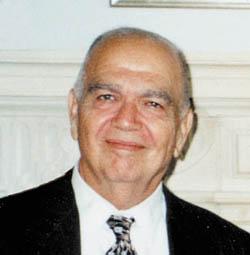By Edward Thurber
Staff Writer
Dr. Richard Hovannisian gave the second of threeHenry S. Khanzadian Kazan Lectures related to the Armenian Genocide of 1915, with a lecture titled “The Last Generation of Ottoman Armenians: Bitter-Sweet Memories,” on Monday evening, October 30th.
 He began with a discussion of his trip to Istanbul, Turkey, where he presented a paper in an International Conference on Oral History, and where he was able to discuss matters of the Armenian Genocide with a largely Turkish audience. Considering the many obstacles he faced to do this, it was quite an achievement. During the conference, he pointed out the categories of coping with the Genocide, which include reconciliation, resignation, repression, revenge and rage.
He began with a discussion of his trip to Istanbul, Turkey, where he presented a paper in an International Conference on Oral History, and where he was able to discuss matters of the Armenian Genocide with a largely Turkish audience. Considering the many obstacles he faced to do this, it was quite an achievement. During the conference, he pointed out the categories of coping with the Genocide, which include reconciliation, resignation, repression, revenge and rage.
He brought to light excerpts from one-hundred survivor interviews contained in the UCLA archives. The interviewees recounted the multi-step process of deportation. The first step was conscription of adults during the first months of the war. The men were later segregated into labor battalions and then killed.
Later, the Turks arrested Armenian leaders and closed down Armenian schools. Turkish town-criers followed, calling people to assemble, and amidst the pandemonium, the deportations began, while more males were separated and killed.
Hovannisian then described how the Gendarmes, Turkish police, forced women and children into the death marches. They faced various cruelties along their path of deportation, including violence against them and starvation.
According to survivor Krikor Ananikian, some women and children saved themselves from the fate of death by assuming new identities and blending into the local populations. Some captive Armenian women were instrumental in helping other Armenians escape.
Survivors feel wronged because of these events. Their only crime was that of being Ottoman Christians. Some of these survivors try to find rationalizations in order to explain the occurrences of the time. There are survivors who clearly remember their lives in the Ottoman Empire. They also fondly remember their early childhood with family and community.
Dr. Hovannisian concluded his presentation by showing excerpts from video interviews conducted with the Genocide survivors. Many students among the more than one-hundred in attendance at the lecture, were deeply moved by seeing the survivors themselves tell their stories.
As the title of the lecture indicated, in a few years, the last survivors of the Armenian Genocide will have passed away. Their bitter-sweet memories, which have been passed to future generations, both directly and through oral histories, will be all that is left to us.
 Hye Sharzhoom Armenian Action
Hye Sharzhoom Armenian Action